Using Apocalypse World to Outline and Draft Your Own RPG
Here in Part 4, I’m talking about playbooks, by request. What are they, do you want them in your game, and what are the alternatives?
This article was made possible by the generous support of my patrons. Please consider joining them by supporting me on Patreon.
Thanks to @dontnormally for the request!
Here’s What
Apocalypse World offers a powerful, flexible framework you can use to outline, draft, and potentially finish your own roleplaying games. Dozens of creators, both experienced designers and first-timers, have used it with great success, and you can too. It’s not a game system as such, it’s an approach to game system design. It’s easy, and it’s a reliable way to get your creative vision quickly into a playable form.
Reminder: The Goal is to Create a Playable Outline
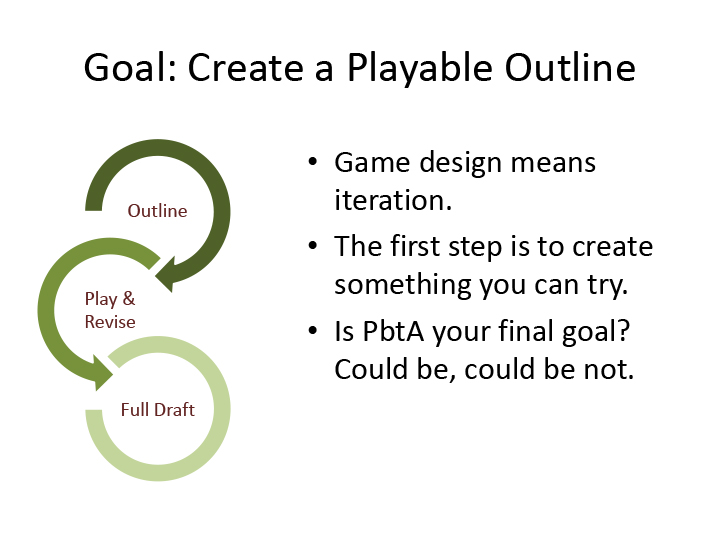
The process of game design for me is intensely iterative: a first stab, then play & revise, play & revise, play & revise. Eventually, after enough iterative cycles, I can make a full draft. Then comes more play and revision as I take the game public, and only once all of those cycles are done do I go on to finish the game for release.
So this series is about only that first goal: to make something you can try. The rest of the process, the vast bulk of the process, we’ll have to take up another time.
I want to emphasize and re-emphasize: maybe, at the end of the iterative process, you have a PbtA game, or maybe you set PbtA aside somewhere along the way and come out with something else altogether. That’s FANTASTIC.
My goal is to get you into the iterative cycle. Whatever comes out of it, is up to you.
So here’s Part 4: Playbooks!
1. What’s a Character?
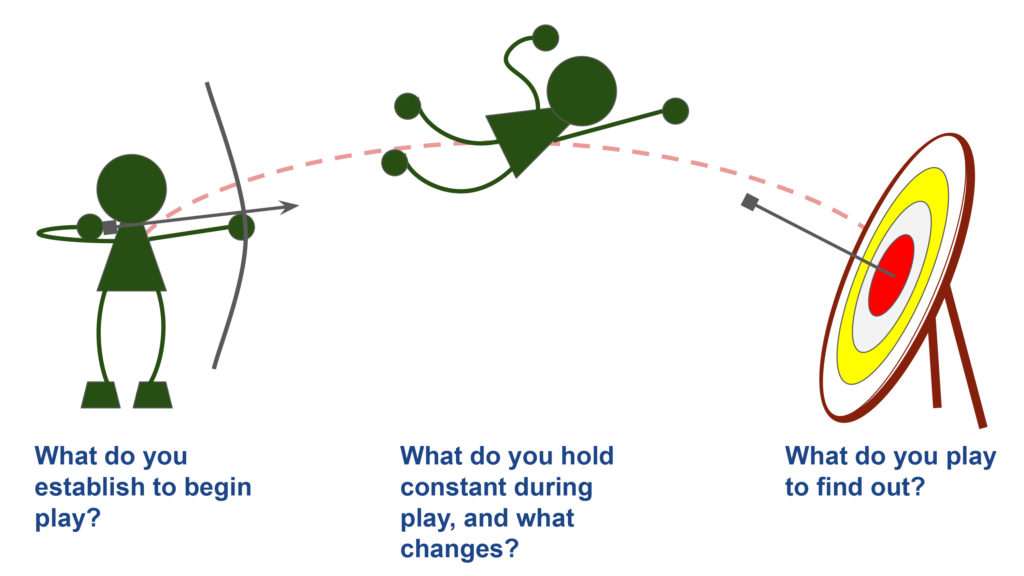
I’m going to start with 3 questions. They’re the 3 questions I always start with: What do we establish before play begins? What remains constant through play and what changes? And what do we need play alone to establish — what do we play to find out?
These are, in my mind, the 3 game questions. They apply to all games; in fact, a game is, in full detail, just and precisely an answer to these questions. Chess, Super Mario Brothers, Eat Poop You Cat, the Lotto, The Bullwinkle and Rocky Role-Playing Party Game, Baseball, you name it: what do we establish in order to play, what do we hold constant throughout play and what do we change during play, and what are we playing to find out.
Since we’re talking about playbooks though, let me rephrase them to center on the characters:
- When you sit down to play an rpg, what do you have to establish about your character in order to begin play?
- When you play an rpg, what about your character remains constant throughout play, and what changes over the course of play?
- What about your character do you leave for play to decide? What about your character do you play to find out?
A roleplaying game character isn’t the same thing as a character in a story, although obviously it’s a related idea. It’s also not the same thing as a pawn in a board game or your character in a video game, although again, obviously related. A roleplaying game character partakes of both.
So in a roleplaying game, the answers to these 3 questions include both fictional content (unlike many non-rpg games) and game content (unlike many non-rpg stories). For instance, in Apocalypse World, to begin play you might establish that your character is a driver named Humphrey with a beautifully-maintained cherry red caddy and a snub nose revolver (fictional content), with +2 Cool, +1 Hot and Sharp, and -1 Weird (game content). As you play, you might hold constant the fact that Humphrey is a driver (or possibly you won’t), but you’ll almost certainly wind up with +3 Cool and more moves than you started with. And this being Apocalypse World, what are you playing to find out? You’re playing to find out what Humphrey makes of his world — both what he chooses and what he’s able to make of it, in concert with the other PCs.
2. A Map to the Playbook
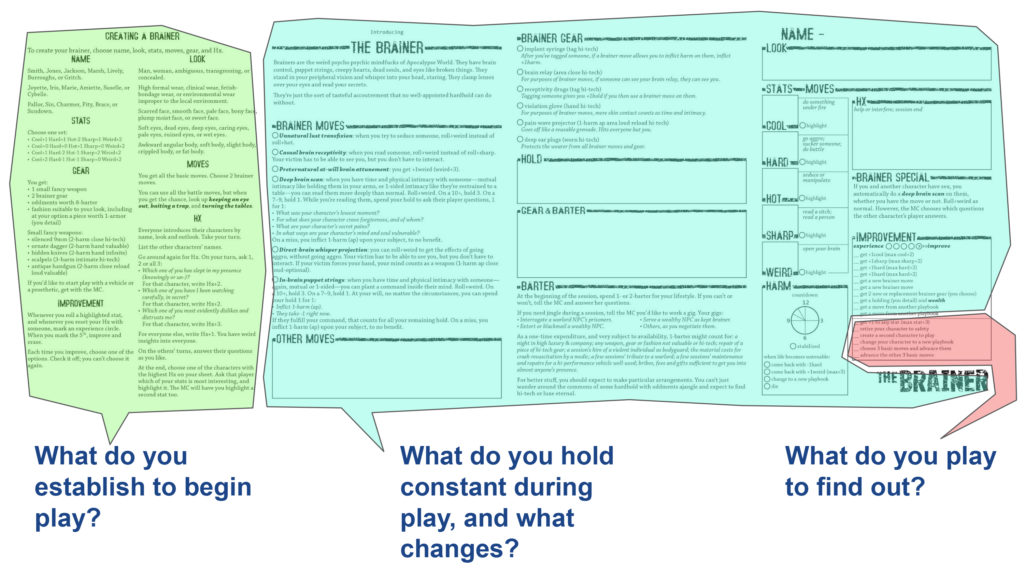
These three questions are a map to the playbook.
The character creation rules tell you what to establish in order to begin playing your character.
The bulk of the playbook’s real estate — in another game, what we’d call the “character sheet” — tracks the character in play, as you hold some things constant and change other things.
And there’s probably some pointer to what you’re playing to find out. In Apocalypse World’s playbooks, it’s pretty cryptic, but if you squint, it’s there.
You can think of a playbook as showing the character’s starting point and trajectory, and maybe their ending point too, depending on the game. Just remember that it’s not only their fictional starting point, trajectory, and ending point, or their gamewise starting point, trajectory, and ending point, but both.
Now let’s talk about a character’s trajectory.
3. Reminder: Apocalypse World’s Conflict Model
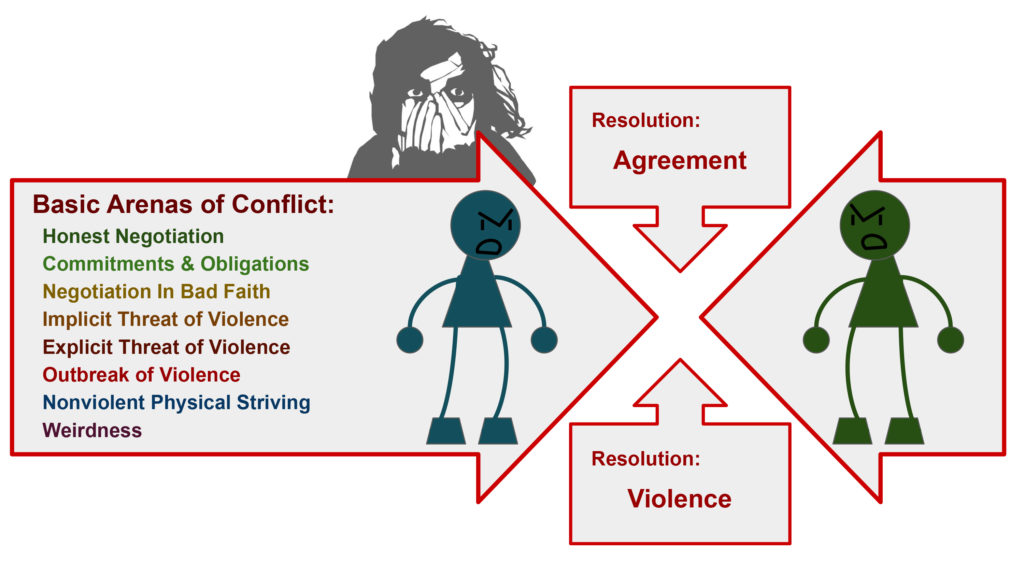
In Part 3, I laid out Apocalypse World’s conflict model. In summary:
- When your character’s vision, best interests, or survival instinct is at odds with someone else’s, your character’s in a state of implicit conflict with them. (Since Apocalypse World is ruled by scarcity, this is the common state of all.)
- With time, and given that both you and they have the means to pursue your interests, you’ll come into conflict and ultimately have to resolve it, either by coming to an agreement or by coming to violence.
- Leading up to this resolution, you’ll both clarify and escalate the conflict between you.
- There are a number of arenas of conflict: different ways to escalate, paths toward the fight or the bargain, means to pursue your interests, modes of aggression to which your character is suited or unsuited.
- The basic arenas of conflict are defined by, but not synonymous with, the basic moves. Apocalypse World’s arenas of conflict include honest negotiation, negotiation in bad faith, implicit and explicit threats of violence, nonviolent physical striving, weirdness, etc.
Today I’ll add:
- In Apocalypse World, your character’s trajectory is their trajectory through these arenas of conflict.
In other words, in order to begin to play Apocalypse World, you must establish your character’s fictional and gamewise position in a state of implicit conflict. Then, during play, what you hold constant and what you change about your character, both depend on and determine how you clarify, escalate, and resolve conflicts, arena to arena. And finally, what you’re playing to find out is, how do you choose to, and how are you able to, resolve conflicts in order to make something of your character’s world.
4. Complicating the Arenas of Conflict
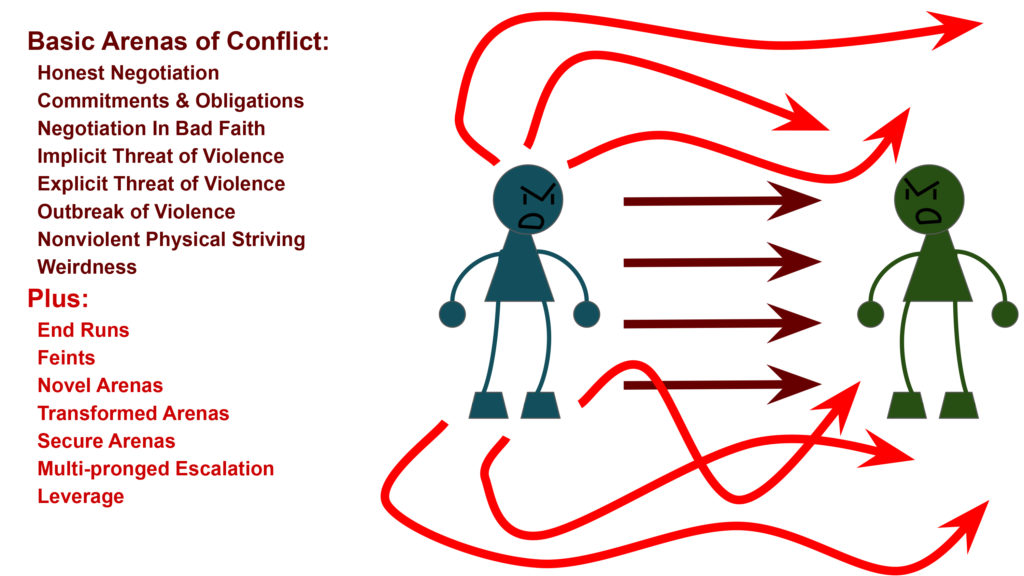
In Apocalypse World, the basic moves and the basic arenas of conflict are not, with a capital NOT, the end of the story. Every playbook is designed not only as a starting position to the basic arenas of conflict, but to break and defy the basic arenas of conflict outright.
Your playbook gives you your strengths and weaknesses in basic conflict with the people whose visions and needs oppose yours. It also gives you a set, a distinct cluster, of strengths and weaknesses outside of the basic arenas of conflict:
- End runs, where you can get the benefits of victory in an arena of conflict without facing the costs and dangers of it;
- Feints, where you misdirect your enemy into opposing you in one arena of conflict while you escalate in another;
- Access to novel arenas of conflict, where you’re difficult to oppose;
- Transformed arenas of conflict, where the stakes, costs, dangers, and victories are different for you than for others;
- Secure arenas of conflict, where you need not oppose your enemy’s escalation after all;
- Multi-pronged escalation, where you can move against your opponent in more than one arena of conflict at once;
- Leverage against your opponent, giving you ways to escalate against them or taking away ways for them to oppose you;
- And presumably others that didn’t happen to come to my mind.
Nonviolent physical striving? The driver can do nonviolent physical striving with cars. The hardholder and the hocus can do it with gangs. The maestro d’ can do it by just putting out the word.
Threats of violence? The chopper and the hardholder can threaten you with a physically violent gang. The gunlugger can stand up to them! The brainer can threaten you with your own mind. The maestro d’ can even make an end run around violence and kill you without a fight.
Clarifying conflicts? The brainer can read your mind. So can the savvyhead, in certain circumstances, in their own way. The maestro d’ can dial in on anybody. The angel can perform augury with somebody’s freaking corpse.
In many games, the basic arenas of conflict, as created by the basic moves, are all the game needs. Not Apocalypse World! Apocalypse World sprawls untidily all over the place. The boundaries of its arenas of conflict can’t contain it.
5. Playbooks: Yes, No, Why, and What Else?
At last we come to it!
In Apocalypse World, for whatever aesthetic and practical reasons Meg and I had as its creators, the conflictwise differences between the characters form distinct clusters. The brainer has this assortment, the driver has this other assortment, the skinner has this other assortment still. At the beginning of play, there’s not much overlap between them. As you change your character in play, they overlap more, via taking moves from other playbooks and other improvement options; and of course you can move your character between them, via changing playbooks, bringing more or less of your old capabilities along and leaving more or less of them behind.
But still: when you start play as a brainer, you don’t have just one or two novel ways to approach conflicts. Between your moves and your gear, you have half a dozen, each one novel in itself, all of them related. Then, in play, it’s easy to expand your approaches in one direction — the brainer direction — and harder to branch out in other directions. In Apocalypse World, this is what a playbook means.
If, for your own aesthetic and practical reasons as a creator, you want your game to have distinct conflictwise clusters like Apocalypse World does, then playbooks are a good way to go!
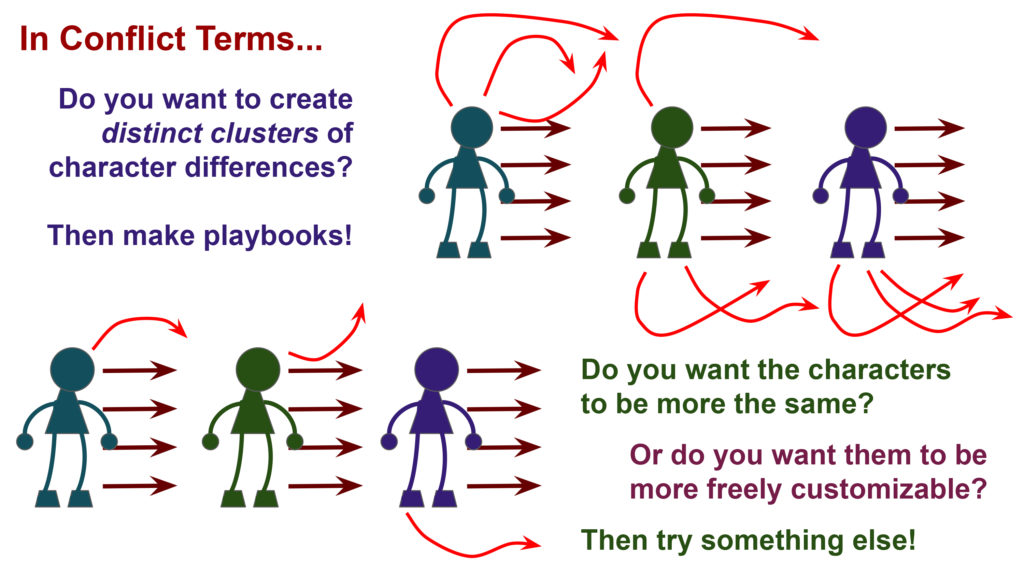
Here are some alternatives to playbooks that I’ve seen and thought about:
Pair-up Playbooks
If the characters in your game have two distinct parts, like a secret identity and a superhero identity, or an earthly self and an astral self, each with its own set of different approaches to conflicts, you might create two different sets of playbooks and have the player choose one of each.
For example: Super Destiny High School Rumble!! by our good friends at The Five Wits Press. In Super Destiny High School Rumble, you play a high school student with a super power, and you choose a playbook for each: as a student you might be the Adorable, the Delinquent, the Friend, the Prodigy, or the Transfer Student; and you might also be the Apprentic Reaper, the Digital Champion, the Mech Pilot, or the Secret Monster.
Point Buy / Free Choice
If, like in Apocalypse World, you want to include lots of different approaches to conflict, beyond the bare arenas offered by the basic moves, but you don’t want to cluster them at all, you might just make a big list of moves and other stuff and let the players choose from them. You might create a point buy system, where some moves or equipment cost more points than others, to reflect their relative effectiveness, or else you might just let everybody choose 3, or whatever other scheme works best for your game.
For example: The Warren by Marshall Miller. In the Warren, there’s one big list of character moves that we all choose from. We each get one new move per session of play, and we have to choose unique moves: no choosing a move that someone else has chosen.
Careers
If you want to create clusters of related capabilities for the characters of your game, but you don’t want to canalize them the way playbooks would, you might create a career system, where the player chooses careers or backgrounds for their character and then chooses moves and equipment or whatever from the subsets of those careers.
For example: Uncharted Worlds by Sean Gomes. In Uncharted Worlds, I might choose Personality and Starfarer for my character’s careers, to play some kind of famous galactic jet-setter, and you might choose Military and Starfarer, to play my more trouble-minded and much more capable bodyguard.
Only One Playbook
It’s possible to create variety between the players’ characters without sprawling all over the place the way Apocalypse World does. If your basic moves and the basic arenas of conflict that they create are all that your game needs, you might give every player the same playbook to customize for their character.
For example, Amazons by yours truly. In Amazons, we both* play characters with the same set of moves, but with different stats, different equipment, and different pasts.
* It’s a game for 2 players plus 2 or more GMs.
No Playbooks At All
The purpose of a playbook is to establish what you need to establish to begin play, then to track through play what changes and what remains constant. In some games, there’s so little to establish, and so little to track, that you might not need playbooks at all.
For example, The Sundered Land, again by Meg and me. The Sundered Land is a suite of games, but the games are so minimal that each fits on a side of a sheet of paper and requires no written records. “We’re caravan guards. I’m dedicated to fallen gods; you’re a master of sword and staff. We need 2 dice and nothing else. When the caravan comes under attack, our one move is to go into conflict and/or expose ourselves to danger. Now we play!”
6. Oh, P.S.
If these arrow diagrams look kind of familiar to you, they should! This is why we called them playbooks in the first place.
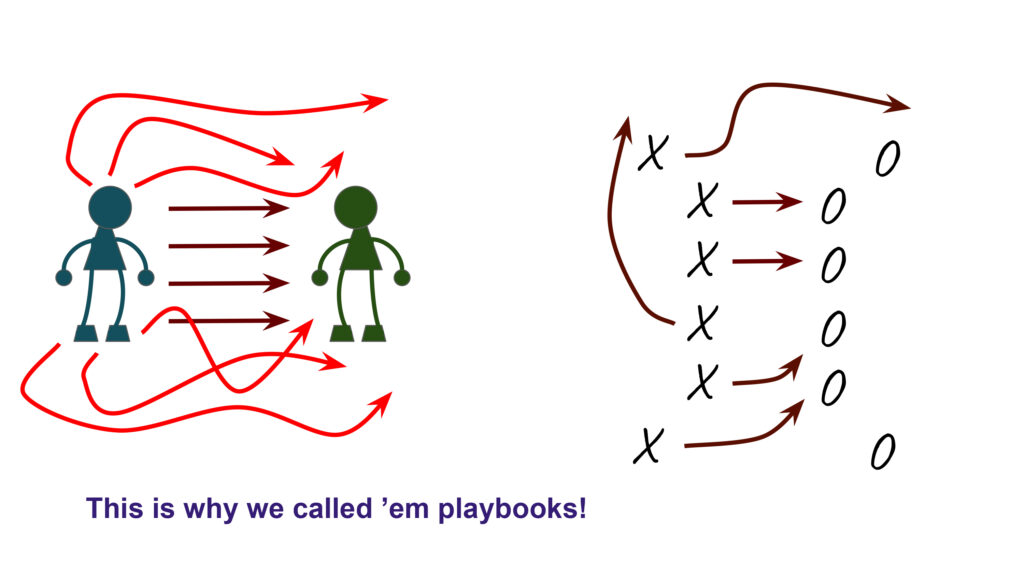
And Remember…

Thanks for reading!
Past Installments:
- Back in Part 1, I laid out Apocalypse World’s philosophy and foundation, described the fit and purpose of its systems, and talked about which features are central to its workings and which aren’t.
- Then in Part 2, I walked through the beginnings of taking Apocalypse World’s parts and using them as the basis for a whole new game.
- In Part 3, I dived back into Apocalypse World’s basic moves. I went through them one by one to talk about how and why they work the way they do.
Next Installments:
- In Part 5, I take a quick aside to talk about some different ways that moves can fit into the conversation of play.
- In Part 6, I use an Ursula K. LeGuin quote — you probably already know the one — as an outline for alternative models to Apocalypse World’s model of conflict.
- Part 7’s a good old-fashioned Q&A, in rounds: Round 1, Round 2, Round 3 (the lightning round!), & Q&A Round 4 (the Final Round!)
- In Part 8, I share my six best, most reliable tricks for drafting interesting moves.
- In Part 9, I lay some groundwork for the idea of underlying models by pointing out a crucial feature of Apocalypse World.
- In Part 10, I develop the idea of underlying models further, with 2 solid examples and 1 tentative one.
- In Part 11, I explore a few of the dice systems we’ve used in our PbtA games.
- In Part 12, I point out a detail in Apocalypse World’s playbook moves that you might have missed.

Cromlyn says:
Dang, these guides leave the plodding detail of skeleton world in the dust.
Did you map out the fields of conflict for each playbook, or did they arise neatly from the archetypes?
Vincent Baker says:
Good question!
As far as my working method goes, I let them arise organically from the archetypes, but I always keep in mind the outer bounds of escalation that I want to maintain, per arena of conflict.
Like, right now, I’m thinking about the Harrier playbook in Burned Over. I want it to have a significant escalatory advantage in violence — of course! — and it does, but is it over the line? I’ll decide by comparing it to the Volatile, actually: I need a Volatile who can, if optimized to do so, give the Harrier pause.
I might end up judging them right on. If I don’t, I might reign the Harrier in by a factor, or punch the Volatile up by a factor, or both; whichever I think will put them better where I want them.
Kyle Parker says:
Could you give some thoughts on the Asset system from Ironsworn?
Vincent Baker says:
I can’t! How does it work?
Kyle Parker says:
So your character has what are called Assets. Which are a collection of typically 3 abilities. An example of a rewording of an Asset I made(Made for Ironsworn: Starforged).
Commander
*You have a crew with a strength of +4. Roll +strength when you
command your crew to Face Danger, Secure An Advantage, or Compel. When
you face the negative outcome of any move, you may suffer -1 strength
as the cost. When you Sojourn and score a hit, take +1 strength. While
at 0 strength, this asset counts as an Impact.
*You may call security to Battle, science to Gather Information or
Engineering to Resupply. If you do, roll +strength.
*Once you Forge a Bond with your crew, take +1 momentum on a hit
when you leverage a crew ability.
These Assets are usually either modifiers to existing moves or new moves. Player characters start with three of these and gain more as they gain experience. So the base character doesn’t really have specific moves, but the assets elaborate the character from the base sheet. So instead of having Playbooks, you have Assets.
Scott says:
Hi, hopefully your still responding to comments here, I’ve been a long time fan of the pbta system and am currently MCing a group.
I’m struggling to find more references to the Vigilants wolves of the maelstrom. There uses? Using them as weapons? As a gang? As insight? Please help because I can structure all the other playbooks to my world except this one and the sheets don’t offer much insight into the original planning or expectation of said book. Maybe im just not reading the right stuff